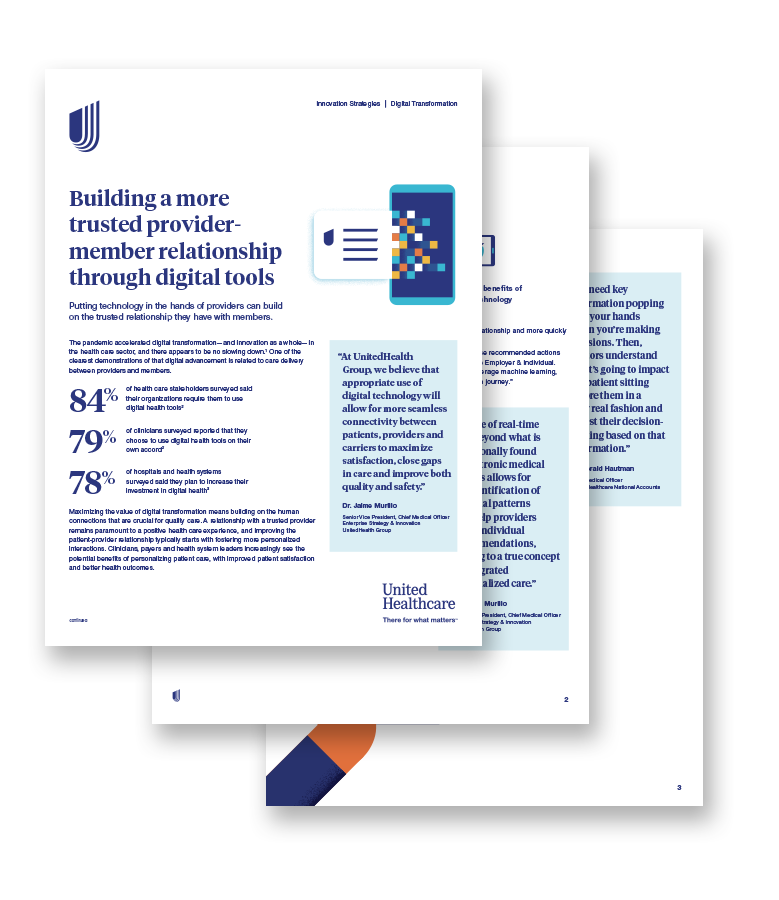Building a more trusted provider-member relationship through digital tools
Putting technology in the hands of providers can build on the trusted relationship they have with members.

The pandemic accelerated digital transformation — and innovation as a whole — in the health care sector, and there appears to be no slowing down.1 One of the clearest demonstrations of that digital advancement is related to care delivery between providers and members.
- 84% of health care stakeholders surveyed said their organizations require them to use digital health tools2
- 79% of clinicians surveyed reported that they choose to use digital health tools on their own accord2
- 78% of hospitals and health systems surveyed said they plan to increase their investment in digital health3
Maximizing the value of digital transformation means building on the human connections that are crucial for quality care. A relationship with a trusted provider remains paramount to a positive health care experience, and improving the patient-provider relationship typically starts with fostering more personalized interactions. Clinicians, payers and health system leaders increasingly see the potential benefits of personalizing patient care, with improved patient satisfaction and better health outcomes.
"At UnitedHealth Group, we believe that appropriate use of digital technology will allow for more seamless connectivity between patients, providers and carriers to maximize satisfaction, close gaps in care and improve both quality and safety,”"says Dr. Jaime Murillo, senior vice president and chief medical officer of Enterprise Strategy & Innovation for UnitedHealth Group.
As a result, two areas of focus emerge that are helping to build on that trusted provider-member relationship and advance the overall care-delivery model: leveraging real-time data and developing tools for efficiency and simplicity.
Leveraging real-time data
New tools are giving patients and providers access to real-time data that can help further inform medical care and encourage healthier lifestyle changes. For example, a continuous glucose monitor (CGM) used with a Fitbit tracker can help those with type 2 diabetes see how food, sleep and movement affect their body in real time without more traditional diabetes management tactics such as fingersticks or frequent doctor visits. Providers with access to the data can track a patient’s daily trends to provide clearer direction based on the patient’s personal preferences.
"When you have that continuous feedback, you can start to really pinpoint the effects of the timing of meals, walks, the hours that you sleep and all of these micro-decisions that you make throughout the day," says Craig Kurtzweil, chief data and analytics officer for UnitedHealthcare Employer & Individual. "Then, for a solution, you don’t have to change your whole world. You can just change a micro-intervention customized to your body and your data — which has a greater opportunity for success."
Technology can also help providers identify patients who may benefit from other supportive care. Primary care physicians often lack the time and resources to evaluate their patients’ mental health during a routine visit. Providing patients with an app that can passively collect information on their mood and mental well-being can help providers identify those who may benefit from mental health services.
"The use of real-time data beyond what is traditionally found in electronic medical records allows for the identification of personal patterns that help providers make individual recommendations, leading to a true concept of integrated personalized care."
"Having data in the hands of somebody who’s completely trusted by the patient at the moment decisions are being made is critical," Kurtzweil says. "It can make the difference in where they go, who they see, what drugs they receive and the outcome of their care."
Developing tools for efficiency and simplicity
With the right tools, physicians can access critical information at the precise moment they need it. This may even include information they don’t know they need in making the best decision for a patient.
"Some doctors may still be using the old method of simply putting in an order without understanding the full impact on the patient," says Dr. Gerald Hautman, chief medical officer for UnitedHealthcare National Accounts. Digital tools can help ensure that information about network providers, quality ratings and details regarding prior authorization are presented on the physician’s screen, when it’s needed in the moment.
UnitedHealthcare offers tools that enable physicians to access useful real-time information. For example, doctors and staff can view precise prescription costs, patient-specific coverage and clinically appropriate alternatives during a patient visit, thanks to technological integrations with electronic medical record platforms. This helps minimize prescription delays, unnecessarily high costs and other barriers that may lead to medication nonadherence.
Looking ahead, sophisticated algorithms have the potential to flag issues that physicians may have missed. Physicians will still make decisions about care, but they would be supported by helpful alerts and information they may not have sought on their own.
“These algorithms will produce new knowledge that will enable providers to optimize care recommendations to their patients, improved care results in better outcomes and lower costs for both the patient — the employee — and ultimately their employer."
"You need key information popping into your hands when you’re making decisions,” Hautman says. “Then, doctors understand what’s going to impact the patient sitting before them in a very real fashion and adjust their decision-making based on that information."